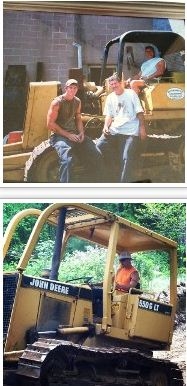We recognize that many people will try to save money on renovations around the house by completing them on their own. Because of the sometimes unpredictable placement of utility lines under your house, trying to handle the excavation on your own could result in serious, costly damage.
Have you thought about the possibility of finding rental equipment to use, or the difficulty it might pose to learn to use it? Why not hire someone who already has the know how? A professional excavator can help.
In 1837, the Otis steam-powered excavator helped eliminate the slow, backbreaking work that had for millennia been done by hand. While the prototype was used to build the Western Railroad line in Massachusetts, it quickly spread into all facets of road and building construction.
If drainage is a problem around your home or business, we have the excavation and earth-moving equipment to properly grade the site and direct the flow away from the structures to where you want it to go.
For building construction, excavation work has two stages. Once the surveyors have finished and determined the boundaries, we come in and dig, grade, and compact the ground. Then, after the foundation is poured, we back fill the area around it.
Earth excavation, which refers to the removal of the layer of soil immediately beneath the topsoil but above the rock, is usually the layer that requires removal when constructing embankments and foundations.
We have plenty of experience clearing sites for construction projects. We can remove trees, tree stumps, and concrete from your site so that it is ready for a foundation or other work.
Are you tired of bumping along the dusty private road that leads to your property? When you’re ready to pave a road that will make transportation more comfortable, we’re ready to handle the roadbed work.
When laying pipes, cable, conduit, or simply digging long stretches of ditch, trenchers are the preferred equipment. Ranging from walk behind designs to heavy-duty, track mounted behemoths, there is a size for every job.
Unfortunately, plumbing pipes don’t always stay intact for the life of a home. When you need to get down to the pipes so that you can determine what’s wrong with it, we can help you remove all the dirt and gravel that may be in the way.
Did you know that, before an excavation project can begin, underground utilities such as sewer, water, gas lines, communications and electric lines must be identified and located? A local area utility locator company can do the work, usually within 48 hours.
No structure will stand the test of time if it is not on a solid foundation, and excavating and preparing the site for the foundation is the first step in superior construction. Once you have your plans drawn up, let us get the site ready.
Before an excavation project can begin, it is necessary to remove any hazardous materials, such as asbestos, from the site.
Foundation work is typically performed by excavation contractors using heavy duty equipment. Excavators are usually used to dig out the foundation and then bulldozers to transfer the excavated dirt and level the large expanses of land.
Whether you need a new road or highway constructed, be it for a large municipal project or simply to make more areas of your property accessible, an excavation service is equipped to handle clearing, grading, and materials removal.
Are you concerned that the underground portion of your next construction project is too ambitious to become a reality? Let’s talk about the nature of the excavation you need and the best way to complete it safely and within your timeframe.
Site excavation is one of the earliest stages in new construction processes, whether it involves buildings, roads, or other structures. Here, the site is excavated and soil, rock, and other materials removed to create a level area in which to work.
Technically speaking, a “bulldozer” refers only to the blade on the front of the equipment, but it has come to define the entire piece. As such, when deciding on how large a bulldozer to use, it is the capacity of the blade that is considered; but the vehicle has to be strong enough to handle it.
Did you know that the topsoil, or mantle soil, contains more moisture than deeper levels of earth do? In any excavation project, we recommend removing the topsoil as soon as possible, as this removes moisture from the site and makes deeper layers of soil much easier to handle.
Your town or municipality usually only runs water and sewer lines along the street, then you’re responsible for the hookups that run from your property line to your house. Excavation experts can help make sure these are installed correctly when you’re building a house.
It’s important to remember that adding a basement after your home is already in place can require more extensive excavations than building it as part of your home. This is especially the case because removing the earth under your home could put your home’s structural integrity at risk.
If you have bought a new, undeveloped piece of property, you may very well have a lot of dirt to move. A professional excavator can help you decide what needs doing, and then can do the work and do it faster and better.







